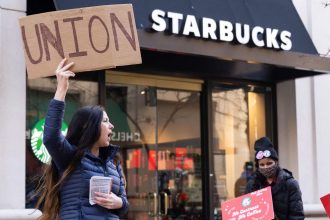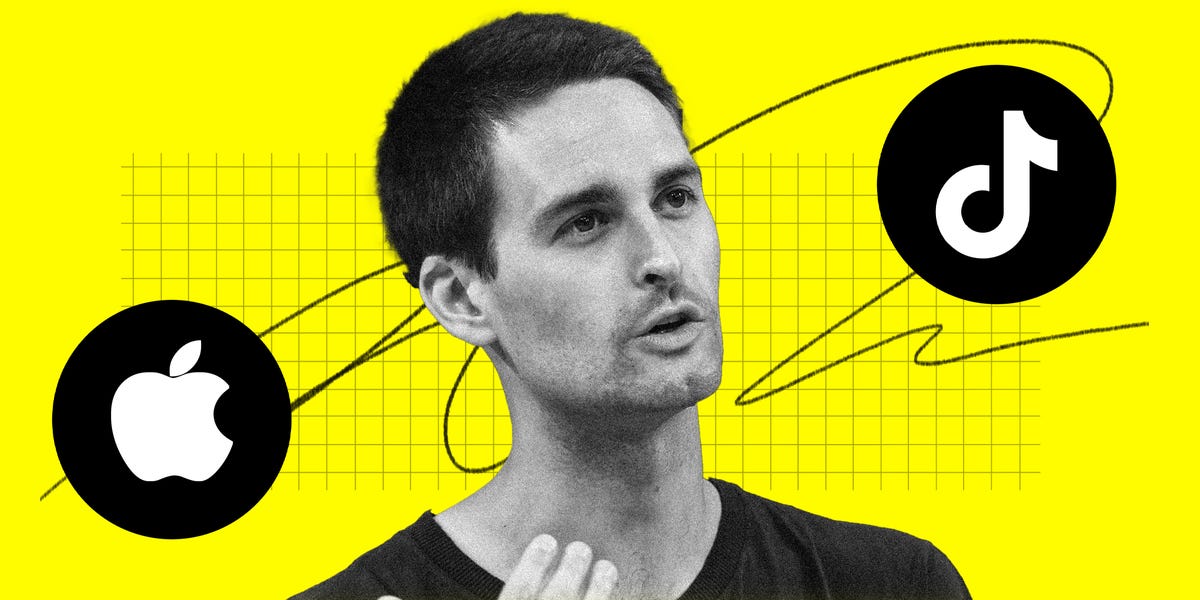Earlier this spring, Snap’s advertising team got an unwelcome jolt.
Amazon, a major Snap advertiser and the world’s biggest advertiser, abruptly cut spend in the first half of 2023, according to a former senior level employee. It was an alarming moment, this person said, because the company’s ads business felt particularly exposed.
Snap’s ad business, which makes up almost all of its revenue, had already suffered flat or declining sales for two quarters before Amazon reduced its Snap ad budget. Snap had already been losing a steady stream of advertisers to TikTok, and was struggling after Apple’s privacy feature dented its ad business significantly.
Amazon did not respond to a request for comment for this story.
But Amazon’s defection seemed to be the turning point, and Snap’s top leadership decided to take a hands-on approach with the advertising teams and their daily work, said the former employee.
Insider spoke to 26 insiders and experts knowledgeable of Snap’s business for this article. Most of those people requested anonymity because they weren’t authorized to talk about the company or feared retribution. Their identities are known to Insider.
“They were being asked to join more client and internal cross functional calls and were massively nitpicking on every piece of work delivered,” this person said, who started looking for another job because of the micromanaging and blame being placed on the ads department for Snap’s woes.
The crackdown further exacerbated the frustrations of many other employees, who were already on edge because they were expecting further layoffs, the former employee said. Snap had cut 20% of staffers last year and this September, it closed its enterprise AR division, eliminating 170 jobs.
Another source familiar with CEO Evan Spiegel’s thinking about Snap’s ads business said: “Evan can see it’s bad and he is not happy.”
Driving ads revenue has become one of Snap’s big ambitions over the next year. One of Spiegel’s stretch goals for Snap in 2024 includes 20% year-over-year ad revenue growth, the Verge reported, noting that Snap had hit only one of its nine stretch goals from the previous year.
The company’s ad business has some significant hurdles to climb. Guideline, which tracks ad-buying data from the world’s largest advertising agencies, reported Snap spend had suffered six months of year-over-year declines, said Darrick Li, Guideline’s VP of business development and strategic partnerships for North America.
The pessimism around Snap’s ad business today is a far cry from when it launched its first ad in 2014 for the horror movie “Ouija,” boasting to advertisers that it offered a new way of reaching Gen Z audiences, and developed new ad units that harnessed augmented reality and vertical video — a format copied by Meta and TikTok.
“You could win a Cannes Lions by doing awesome shit on Snapchat,” said another former Snap ad executive who spoke anonymously for fear of retribution. A Cannes Lions is a major ad industry award.
In focusing on ad innovation however, Snap struggled to develop necessary features that were on par with competing digital ad platforms, like measurement for performance advertisers or audience targeting that could withstand privacy restrictions from Apple.
“Snap almost suffers from a first-mover disadvantage — they run through the door first, then they trip,” said an ad buyer.
“They wished Snap worked as well as TikTok”
In 2019, TikTok was on a blitz to attract users — and it was using Snap ads to get them, so much so that it became Snap’s biggest advertiser in 2020.
Spiegel initially dismissed the idea that TikTok would be a major competitor, according to a person familiar with his thinking at the time. Instead, Spiegel said TikTok was a music and entertainment app whose biggest challenge was managing its relationship with music labels, this person recalled. When asked by an analyst whether TikTok was a “friend or foe,” Spiegel said friend — both as a developer and advertiser partner. But the next year, at a JP Morgan conference, he acknowledged that “they’re going to be very competitive.”
“They’re extremely aggressive, and we really admire them, frankly, and have learned a lot from them,” Spiegel said at that event.
TikTok was siphoning Snap’s valuable millennial and Gen Z audiences, causing advertisers to shift budgets, according to ad buyers and former employees. (Snap pointed to a recent study it commissioned from GWI showing that 43% of Snap’s users over the age of 16 don’t use TikTok every day.)
Performance advertisers, who are known for scrutinizing whether ads drove sales, started telling Snap that performance was better on TikTok, said the second former Snap exec. TikTok promised cheaper ad prices, and an audience similar in makeup to Snap’s, but bigger in size.
Spiegel requested Snap’s ad teams to ask performance advertisers for examples of the ad creative that worked on TikTok, but not Snap, so that Snap could improve, said the former exec. Some performance advertisers agreed to share these examples, this former exec said.
“The performance guys want everything that works — they wish Snap worked as well as TikTok,” this person said.
That feedback was used to help personalize what ads people see on Snap, the person said.
But for all Snap’s ability to tweak its ads business to keep up with TikTok, it would soon face a bigger threat that would completely upend its performance: Apple.
Snap has struggled to recover from Apple’s privacy policy
In 2020, Snap employees were working on overdrive to retool its ad business, anticipating a tsunami that the entire digital ad industry could see cresting the horizon. Apple had announced that year it would soon roll out a massive consumer privacy feature that would inhibit tracking across its app environment, and ultimately cause the ad-supported tech industry to lose hundreds of billions in market value.
It was common for some Snap employees to work 80 to 90 hour weeks, solely focused on the upcoming privacy changes, said the former Snap executive.
“We understood it was going to have a big impact and got to work on it right away; we made a lot of progress on it,” this person said.
For a brief while, Snap seemed to surge under the leadership of ads boss Jeremi Gorman, as it attracted users, influencers, and tantalized advertisers with promising new ad products. But Apple’s impact hadn’t yet hit, and when it finally did, it would be a major reality check for the company.
“What we didn’t realize were the secondary effects of this — you can only simulate it, but don’t know how advertisers will react,” the former exec said.
For instance, Snap saw a sharp dropoff in the performance of app-install ads in late 2021, Snap CFO Derek Andersen said during an earnings call. App-install ads are a core performance ad format that Snap had long built specific products to support. Other digital ad platforms, including Meta and Google, also saw app-install performance crater.
“It was like the stock market just changed — everything just broke, it felt like overnight,” the former Snap exec said.
“They didn’t realize how much Apple’s changes would impair their ability to measure the effectiveness of ad campaigns on Snap,” said Mark Mahaney, Evercore ESI managing director.
It hasn’t been all downhill. The performance of the app-install ads did improve after that initial decline, Snap’s Andersen said during the earnings call. And Snap said the improvements it had made to its platform had increased “purchase related conversions” by more than 30% compared with the prior quarter.
But in recent quarters, Snap has not seen the same revenue recovery that companies like Meta have. Snap said in August that its third-quarter earnings, scheduled for Oct. 24, could be flat to down 5% year-over-year.
“They’ve for sure fallen behind Meta, Instagram, TikTok, and Pinterest,” said the ad buyer about Snap’s measurement products. “They were the second choice after Meta for a long time, but they’re the only laggards with X right now.”
Meta in particular is leaps ahead of Snap with AI and its ad tools, said three former Snap employees.
Snap doesn’t have the volume and quality of data that Meta uses to train its AI. For instance, consumers don’t interact with businesses on Snap the way they do on Meta, which means Snap’s data is less useful to advertisers than Meta’s.
“Meta has a ton of data, orders of magnitude more than any of its smaller competitors,” said Andrew Covato, a former Snap ad employee and current advertising consultant. This makes Meta better positioned to fill in the gaps caused by lost Apple iOS signals to figure out which ads were most effective at getting consumers to take certain actions, he said.
Snap has struggled to iron down its leadership team
One problem was that Snap’s advertising leadership was run by longtime ad sales veterans like Jeremi Gorman and Peter Naylor who had experience selling ads to big brands but not with smaller companies, said another former Snap exec. Gorman and Naylor left Snap to head up Netflix’s ad business in 2022.
“When you ask your business to be run by someone who runs large enterprise products, the only focus is on big brands,” this person said.
That’s a problem for any ad company that wants to build a large ad business that can withstand economic volatility. Ad giants like Google and Meta get most of their revenue from numerous small and mid-sized businesses, who are always buying Google search ads or using Meta to drive sales, while the bigger, splashier brands that Snap courts don’t always run campaigns on the platform, and will cut spend during times of economic volatility.
Snap is making aggressive changes to its ads business. Spiegel said during Snap’s earnings call in July, that it was focused on marketing its direct response ad tools. DR tools are used by performance advertisers, who typically invest in them even during economic uncertainty because they help drive business.
Snap also hired staffers to fix its adtech infrastructure earlier this year, like Google and Amazon alum Eric Young, and Google and Meta alum Darshan Kantak.
And Snap has beefed up its ads leadership ranks with executives like Patrick Harris, who ran Meta’s global agency sales, Ronan Harris, who oversaw Google’s UK business, and Ajit Mohan, who ran Meta’s India business.
However, it remains to be seen whether these staffers are in for the long haul. Snap has seen major ads leadership attrition. After Gorman and Naylor departed, another top ad exec Dave Roter left this year for Netflix. Other key losses in the past year include VP of ads product Lars Hirsch. Most notably, Microsoft ad boss Rob Wilk was hired in March to lead Snap’s business in the Americas, but left in September.
There’s certainly no consensus around what strategy Snap’s ads business needs to take. On the one hand, former Snap employee Covato said brands should treat Snap like TV advertising for big, splashy awareness campaigns — and that it shouldn’t be compared to Meta.
Others, like Guideline’s Li, think Snap needs to zero in on building the type of performance marketing tools that Meta provides.
“They are competing for dollars in a very complex ad market [with] more and more options for advertisers to consider their money,” he said.
Whatever direction the company takes, one former executive said they have trust in Spiegel’s vision.
“No one questions if Evan is the right leader,” this person said. “He insisted on ads being right for the user experience — versus just taking the money. He invented the Stories format, and look, everyone copied it. He’s forward-looking.”
Read the full article here





